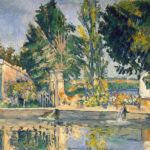Dark Period
Dark Period
Paris, 1861–1870

In 1863 Napoleon III created by decree the Salon des Refusés, at which paintings rejected for display at the Salon of the Académie des Beaux-Arts were to be displayed. The artists of the refused works included the young Impressionists, who were considered revolutionary. Cézanne was influenced by their style but his social relations with them were inept—he seemed rude, shy, angry, and given to depression. His works of this period are characterized by dark colours and the heavy use of black. They differ sharply from his earlier watercolours and sketches at the École Spéciale de dessin at Aix-en-Provence in 1859, and their violence of expression is in contrast to his subsequent works.
In 1866–67, inspired by the example of Courbet, Cézanne painted a series of paintings with a palette knife. He later called these works, mostly portraits, une couillarde (“a coarse word for ostentatious virility”). Lawrence Gowing has written that Cézanne’s palette knife phase “was not only the invention of modern expressionism, although it was incidentally that; the idea of art as emotional ejaculation made its first appearance at this moment”.
Among the couillarde paintings are a series of portraits of his uncle Dominique in which Cézanne achieved a style that “was as unified as Impressionism was fragmentary”. Later works of the dark period include several erotic or violent subjects, such as Women Dressing (c. 1867), The Rape (c. 1867), and The Murder (c. 1867–68), which depicts a man stabbing a woman who is held down by his female accomplice.
